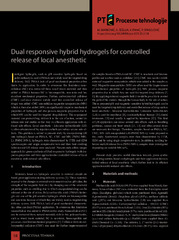Dual responsive hybrid hydrogels for controlled release of local anesthetic
Чланак у часопису (Објављена верзија)
Метаподаци
Приказ свих података о документуАпстракт
Intelligent hydrogels, such as pH sensitive hydrogels based on
poly(methacrylic acid) (PMAA) are widely used for targeted drug
delivery. Still, PMAA lack of good mechanical properties often
limits its application. In order to overcome this limitation nano cellulose (NC) was extracted from wood waste material and then
added to PMAA because NC is biocompatible, non-toxic and has
excellent mechanical properties. Further, carboxymethyl cellulose
(CMC) (cellulose derivate widely used for controlled release of
drugs) was added. CMC can stabilize magnetite nanoparticles (MN)
which is then also added. MN can significantly improve mechanical
properties of hydrogels and also possess magnetic properties due to
which MN can be used for targeted drug delivery. The as-prepared
material can protect drug, deliver it to the site of action, control its
release rate and enable in that way its efficient application with re duced side effects. Local anesthetic - lidocaine hydrochlor...ide (LH)
is often administrated by injection which can induce severe side ef fects. This problem is solved in present study by encapsulating LH
into hydrogels based on PMAA, NC, CMC and MN (PMNC/MN L). PMNC/MN-L hydrogels were characterized by FTIR and SEM
spectroscopies and single compressive tests and then their swelling
behavior and LH release were analyzed. Present study offers unique
approach for green synthesis of dual responsive hydrogels with im proves properties and their application for controlled release of local
anesthetic with reduced side effects.
Извор:
Procesne tehnologije, 2021, 33, 2, 18-24Издавач:
- Savez mašinskih i elektrotehničkih inženjera i tehničara Srbije (SMEITS)
Финансирање / пројекти:
- Министарство науке, технолошког развоја и иновација Републике Србије, институционално финансирање - 200287 (Иновациони центар Технолошко-металуршког факултета у Београду доо) (RS-MESTD-inst-2020-200287)
Колекције
Институција/група
Inovacioni centarTY - JOUR AU - Marković, Maja AU - Šešlija, Sanja AU - Panić, Vesna AU - Spasojević, Pavle PY - 2021 UR - http://TechnoRep.tmf.bg.ac.rs/handle/123456789/5073 AB - Intelligent hydrogels, such as pH sensitive hydrogels based on poly(methacrylic acid) (PMAA) are widely used for targeted drug delivery. Still, PMAA lack of good mechanical properties often limits its application. In order to overcome this limitation nano cellulose (NC) was extracted from wood waste material and then added to PMAA because NC is biocompatible, non-toxic and has excellent mechanical properties. Further, carboxymethyl cellulose (CMC) (cellulose derivate widely used for controlled release of drugs) was added. CMC can stabilize magnetite nanoparticles (MN) which is then also added. MN can significantly improve mechanical properties of hydrogels and also possess magnetic properties due to which MN can be used for targeted drug delivery. The as-prepared material can protect drug, deliver it to the site of action, control its release rate and enable in that way its efficient application with re duced side effects. Local anesthetic - lidocaine hydrochloride (LH) is often administrated by injection which can induce severe side ef fects. This problem is solved in present study by encapsulating LH into hydrogels based on PMAA, NC, CMC and MN (PMNC/MN L). PMNC/MN-L hydrogels were characterized by FTIR and SEM spectroscopies and single compressive tests and then their swelling behavior and LH release were analyzed. Present study offers unique approach for green synthesis of dual responsive hydrogels with im proves properties and their application for controlled release of local anesthetic with reduced side effects. PB - Savez mašinskih i elektrotehničkih inženjera i tehničara Srbije (SMEITS) T2 - Procesne tehnologije T1 - Dual responsive hybrid hydrogels for controlled release of local anesthetic EP - 24 IS - 2 SP - 18 VL - 33 DO - 10.24094/ptc.021.33.2.18 ER -
@article{
author = "Marković, Maja and Šešlija, Sanja and Panić, Vesna and Spasojević, Pavle",
year = "2021",
abstract = "Intelligent hydrogels, such as pH sensitive hydrogels based on
poly(methacrylic acid) (PMAA) are widely used for targeted drug
delivery. Still, PMAA lack of good mechanical properties often
limits its application. In order to overcome this limitation nano cellulose (NC) was extracted from wood waste material and then
added to PMAA because NC is biocompatible, non-toxic and has
excellent mechanical properties. Further, carboxymethyl cellulose
(CMC) (cellulose derivate widely used for controlled release of
drugs) was added. CMC can stabilize magnetite nanoparticles (MN)
which is then also added. MN can significantly improve mechanical
properties of hydrogels and also possess magnetic properties due to
which MN can be used for targeted drug delivery. The as-prepared
material can protect drug, deliver it to the site of action, control its
release rate and enable in that way its efficient application with re duced side effects. Local anesthetic - lidocaine hydrochloride (LH)
is often administrated by injection which can induce severe side ef fects. This problem is solved in present study by encapsulating LH
into hydrogels based on PMAA, NC, CMC and MN (PMNC/MN L). PMNC/MN-L hydrogels were characterized by FTIR and SEM
spectroscopies and single compressive tests and then their swelling
behavior and LH release were analyzed. Present study offers unique
approach for green synthesis of dual responsive hydrogels with im proves properties and their application for controlled release of local
anesthetic with reduced side effects.",
publisher = "Savez mašinskih i elektrotehničkih inženjera i tehničara Srbije (SMEITS)",
journal = "Procesne tehnologije",
title = "Dual responsive hybrid hydrogels for controlled release of local anesthetic",
pages = "24-18",
number = "2",
volume = "33",
doi = "10.24094/ptc.021.33.2.18"
}
Marković, M., Šešlija, S., Panić, V.,& Spasojević, P.. (2021). Dual responsive hybrid hydrogels for controlled release of local anesthetic. in Procesne tehnologije Savez mašinskih i elektrotehničkih inženjera i tehničara Srbije (SMEITS)., 33(2), 18-24. https://doi.org/10.24094/ptc.021.33.2.18
Marković M, Šešlija S, Panić V, Spasojević P. Dual responsive hybrid hydrogels for controlled release of local anesthetic. in Procesne tehnologije. 2021;33(2):18-24. doi:10.24094/ptc.021.33.2.18 .
Marković, Maja, Šešlija, Sanja, Panić, Vesna, Spasojević, Pavle, "Dual responsive hybrid hydrogels for controlled release of local anesthetic" in Procesne tehnologije, 33, no. 2 (2021):18-24, https://doi.org/10.24094/ptc.021.33.2.18 . .



